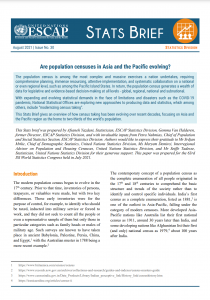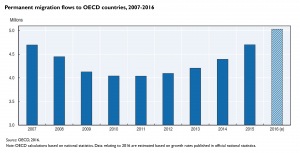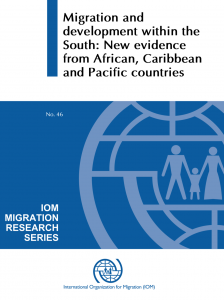
Migration data in Oceania
Oceania is comprised of island nations with few shared land borders spread across the Pacific Ocean. Traditionally, the ocean was seen to connect people through a ‘sea of islands’ (Hau’ofa et al., 1993), resulting in the region’s current identity as the ‘Blue Pacific Continent.’ Its 14 countries are grouped into four geopolitical sub-regions: Australia and New Zealand; Melanesia (Fiji, Papua New Guinea, Solomon Islands and Vanuatu); Micronesia (Kiribati, the Marshall Islands, Federated States of Micronesia, Nauru and Palau), and Polynesia (Samoa, Tonga, and Tuvalu). There are nine semiautonomous territories[1] in Oceania that do not maintain representation at the United Nations, and unless specified otherwise, these are not included in the following analyses.
Oceania is a region of migrants: there were an estimated 9.1 million migrants amongst the region’s 41.8 million people as of mid-year 2020 (UN DESA, 2020). With migrants comprising approximately 22 per cent of the population, the region far outstrips global averages. The countries with the highest proportion of migrants in their population are Australia (30%), New Zealand (29%), Palau (28%) and Nauru (20%). In contrast, on average, migrants represent only 2.1 per cent of the population in the region’s other countries[2].
More than half of the 2 million migrants originating from the countries and semiautonomous territories in Oceania remained in the region, reflecting both economic opportunity and sociopolitical ties. This includes more than 61,000 people from Oceania who had migrated to one of the nine semi-autonomous territories located within the Pacific Ocean. Some major destinations among these territories include American Samoa (18,248), New Caledonia (16,651) and Guam (15,370) (ibid.). In contrast, the majority of the 598,765 Australians living abroad have moved beyond the region, reflecting ongoing ties to the United Kingdom and the more recent origins of post-World War II migrants.
Recent trends
COVID-19
As a result of COVID-19, all countries in Oceania introduced stringent border restrictions, including closed airports, seaports and land border crossings and strict quarantine measures. While these responses reduced transmission, they came at tremendous cost as the region’s economy is heavily dependent on international tourism. For example, the number of visitor arrivals to Fiji dropped from 894,389 in 2019 to 146,905 in 2020 and 31,618 in 2021, with tourism earnings drastically reduced since March 2020. Mobility restrictions due to COVID-19 have also disrupted labour migration as well as critical sources of employment and income the Pacific region (World Bank, 2021). Thousands of migrants in Australia had lost their jobs due to the downturn, or their right to work due to the expiry of their original visa (Australian Red Cross, 2020).
According to estimates, rising unemployment and inability to travel or work abroad due to COVID-related restrictions led to an estimated 79 per cent decline in remittances to East Asia and the Pacific in 2020 (Ratha et al., 2021a). Projections for 2021 expect remittances to East Asia and the Pacific to have slowly recovered by 1.4 per cent (Ratha et al., 2021b).
Australia and New Zealand have been both hit hard by the lack of international students during the pandemic (Australian Bureau of Statistics, 2021; New Zealand Government, 2020) but are slowly starting to reopen their borders for international students again (New Zealand Government, 2022; Australian Department of Home Affairs, 2021).and seasonal labourers (Australian Department of Education, Skills and Employment, 2022; Government of New Zealand, 2022).
‘Brain Drain’ versus Remittance Gain
For many Pacific Island countries, the emigration of workers can cause shortages in key professions, but results in the benefit of remittances from migrants and new skills amongst returnees. For instance, the “brain drain” of health professionals emigrating from Fiji, Papua New Guinea, Samoa and Tonga has contributed to a shortage of health workers in those countries (Yamamoto et al., 2012). Meanwhile, remittances account for a significant share of the GDP in the region. Seven of the top 10 remittance receiving countries in the world in 2020 (by share of GDP) were in the Pacific region , including 38per cent of Tonga’s GDP – the highest of any country in the world ,(World Bank, 2020b).
Anticipating climate- and environmentally-induced migration
Many of the countries of Oceania are acutely vulnerable to the impacts of environmental and climate change. While planned relocation is the least preferred option (Gharbaoui and Blocher, 2018), governments agree that migration linked to adverse climate impacts will become more common as disasters become more severe and impacted territories become uninhabitable (McMichael et al., 2019). Kiribati is expected to be unfit for human habitation by 2035, with existing internal displacement from low-lying islands and coastal regions causing overcrowding and limited access to basic resources (Cauchi et al., 2019). Planned relocation of communities has already occurred in Fiji, Papua New Guinea and Vanuatu (IOM and UN-OHRLLS, 2019), and several Pacific countries have developed national frameworks to plan for this phenomena, including Fiji (2019) and Vanuatu (2018). As a potential destination country, New Zealand’s Cabinet (2018) proposed an action plan for responding to climate-induced displacement and migration in the Pacific. A regional framework is under consideration (IOM, 2020a), with the support of the Pacific Climate Change Migration and Human Security Programme (IOM, 2019). A landmark decision from the UN Human Rights Committee (2020) recognizes that States shall refrain from sending people back to situations in which the impacts of climate change in the country of origin pose a risk to their life with dignity (principle of non-refoulement). The Committee’s conclusions underscore the urgency for States to open new regular migration pathways and provide temporary and longer-term forms of protection to people who would face life-threatening climate risks in case of return to their country of origin. The decision also highlights that the affected States need the support of the international community to address the immense challenges posed by climate change (IOM, 2020b).
As of mid-2021, the top three countries in the region hosting refugees and asylum seekers were Australia (136,000), Papua New Guinea (12,000) and New Zealand (2,400) (UNHCR, 2021). As of mid-2021, most refugees and asylum seekers in Australia originated from Malaysia (18,943), China (17,299), the Islamic Republic of Iran (16,016), Afghanistan (11,990) and Pakistan (7,765). For 2021 and 2022, Australia and New Zealand have allocated 13,750 places and 1,500 places respectively to the UNHCR’s refugee resettlement programme (Australia Department of Home Affairs, 2021a; New Zealand Immigration, 2021a) but New Zealand has already announced that due to COVID-19 this quota won’t be met in 2021/22 and only 750–1,000 individuals will be resettled. On 24 March 2022, the governments of Australia and New Zealand announced that New Zealand will resettle refugees subject to Australia’s offshore transfer policy and will annually for three years resettle 150 refugees located on Nauru or in Australia (UNHCR, 2022). In 2021, 1,839 refugees were resettled to Australia through resettlement schemes, most of them originating from Afghanistan (548), Iraq (401and the Bolivarian Republic of Venezuela (175).
Past (and present) trends in migration
A history of movement
Aboriginal and Torres Strait Islander peoples are the region’s earliest migrants, having first arrived on the continent 65,000 years ago (Clarkson et al., 2017), with Papua New Guineans arriving approximately 50,000 years ago (O’Connell, 2015). The islands of the Pacific Ocean were settled later in waves moving from west to east around 3,000 years ago (Lee, 2009). Aotearoa/New Zealand was the last major land mass to be settled between 1250 and 1300 (New Zealand Ministry for Culture and Heritage, n.d.). Inter-island migration and trade was a feature of the pre-colonial Pacific communities (Choo, 1994).
Colonization of the region involved power struggles between the United Kingdom, France, Spain, the Netherlands, Germany, the United States and Japan. The only country to resist colonial appropriation was Tonga, which remained self-governing throughout (Lee, 2009). Strong postcolonial ties remain with the United Kingdom, the United States of America, and France. Colonization instigated new waves of migration to the region, kicked off by missionaries and traders (Matsuda, 2012). Around 160,000 convicts were transported to Australia in the early colonial period, while more than 62,000 South Sea Islanders were brought in as indentured labourers in a process known as “blackbirding” (National Museum of Australia, 2020). In this period, British colonialists also brought substantial numbers of indentured labourers from India to Fiji (Lal, 2012). The region’s history of human movement is reflected in current movement within the region and with former colonial powers.
Current immigration trends
Australia, the largest country in terms of population, land mass, and economic activity, is the region’s lead host of migrants. The country has maintained a large immigration programme over many decades, recruiting migrants to tackle population concerns and address labour shortages since the end of World War II (Richards, 2008). As a result, 30 per cent of the 25.5 million residents of Australia at mid-year 2020 – or 7.7 million people – were born in another country (UN DESA, 2020). While they represent every country in the world, the main countries of origin were: the United Kingdom (1,29million), China (653,232), New Zealand (611,266), India (579,264), and the Philippines (286,303) (ibid.).
New Zealand is the second major destination for migrants to the region. Almost 29 per cent of its population – approximately1.4 million of its 4.8 million residents – were born in another country. At mid-year 2020, it hosted sizeable numbers of migrants from the United Kingdom (286,746), China (144,207), India (122,506), Australia (85,289), and South Africa (73,846) (ibid.).
The remaining 75,479 migrants in countries in the region were dispersed across the Pacific Island countries. Almost half of these live in Papua New Guinea (including 11,429 Indonesians, 9,219 Australians and 1,783 New Zealanders), and another 14, 087 migrants live in Fiji (ibid.).
Migration is key to the region's economy
Migration is integral to the economy of Oceania. The ageing populations of some countries rely on migrants to maintain the relative proportion of working-age adults, to counter the departure of citizens, and to compensate for low birth rates that fall below population replacement levels (Australian Government Productivity Commission, 2006; Carrington et al., 2008). International education is a significant industry for both Australia (worth AUD 37.6 billion) and New Zealand (worth NZD 5.1 billion), with annual student arrivals of approximately 550,000 in Australia and 125,000 in New Zealand. The region is also reliant on a strong tourism industry, with some countries experiencing bursts of tourist arrivals that far outnumber resident populations. In 2019, Palau’s 18,000 residents hosted almost 90,000 visitors in 2019 – almost five times its population (Palau Government, 2020b). Similarly, Fiji’s 880,000 residents hosted 894,000 tourists (Fiji Bureau of Statistics, 2019), with tourism contributing 34 per cent of the country’s GDP in 2019 (World Travel and Tourism Council, 2019). These large numbers place particular demands on migration authorities, many of which are operating with modest human and financial capital. Meanwhile, as noted earlier, remittances make a substantial contribution to the economies of several Pacific Island nations.
Seasonal labour schemes
Australia and New Zealand offer seasonal labour schemes that enable short- to medium-term migration to fill labour shortages in industries with seasonal demand (Brickenstein, 2015). Australia offers two such labour schemes. The Seasonal Worker Programme enables agricultural and accommodation companies in particular regions to recruit labourers from nine Pacific Island countries and Timor-Leste to work for up to nine months over an 11 month period. Since 2012, it has filled over 30,000 jobs. The complementary Pacific Labour Scheme, launched in 2018, enables approved employers from a wide range of industries to recruit semi-skilled workers from 10 Pacific countries to migrate to Australia for up to three years. The AUD 14.4 billion agriculture industry relies heavily on the labour thus supplied, along with working holiday makers. COVID-19 border closures have caused labour shortages which pose a serious risk for horticultural production (Australian Department of Agriculture, Water and the Environment, 2020).
In New Zealand, the Recognised Seasonal Employer scheme allows the horticulture and viticulture industries to recruit workers from Pacific Island nations for seasonal work. Workers can stay in New Zealand for up to seven months. Implemented in 2007, as of 2020 it is capped at 14,400 places annually.
Australia’s offshore processing arrangements
Australia has a national asylum system in place to determine whether people claiming asylum are refugees and are owed protection (UNHCR, n.d.), and implements policies which prevent people who arrive by boat from seeking asylum. According to the Australian Department of Home Affairs (n.d.), anyone who attempts an unauthorized boat voyage to Australia is turned back to their point of departure, returned to their home country or transferred to another country for processing. This has included transfer to a processing centre in Nauru or, previously, Papua New Guinea (Australian Border Force, 2019a). Between 2012 and2019, over 4,100 people were transferred under these arrangements including 120 children (Australian Border Force, 2019b). As of 30 September 2020, 208 refugees, 23 asylum seekers, and 60 refused claimants remained in the community in Nauru or Papua New Guinea, while 900 refugees had been resettled to third countries (Australia Department of Home Affairs, 2020c). In addition, as of March 2020, 1,220 were in Australia as transitory persons under medical treatment provisions (Australian Senate, 2020). Key UN bodies, including the UNHCR and OHCHR, have criticized these arrangements for failing to comply with human rights standards. On 6 October 2021, the government of Australia announced that it would stop offshore processing in Papua New Guinea by the end of 2021 (ASRC, 2021).
Back to topData sources
The UN Department of Economic and Social Affairs Population Division publishes data on international migration including the international migrant stock for all countries (including demographics, origin and destination, and net migration), analyses of key trends, and some analysis of relevant policies. Its regional definition of Oceania includes nine territories not included here. The UN High Commissioner for Refugees provides Population Data including via its Population Statistics Database. Data is available for all countries, with capacity to segment based on protection status, demographics, and geography.
The Pacific Community’s Statistics for Development Division plays a key role in supporting and coordinating the delivery of official statistics for 22 Pacific Island countries and territories (excluding Australia and New Zealand). It does not focus on migration, but includes population and visitor arrivals, which are collated in the Pacific Data Hub. Each country’s department of immigration and bureau of statistics provide additional data.
The Internal Displacement Monitoring Centre’s Pacific Response to Disaster Displacement Project is working to generate new evidence to better understand, plan for, prevent, and respond to disaster displacement in the Pacific. This includes working with the National Disaster Management Offices in the Pacific to collect and analyse relevant information, and to disseminate these data via the IDMC Global Internal Displacement Database and the IOM’s Displacement Tracking Matrix.
Academic work on migration in Oceania is not collated in a single site, but rather within supra‑regional (Asia-Pacific) or national collections. Migration centres including a focus on Asia include the Migration Policy Institute’s Asia and Pacific regional page and the Mixed Migration Centre Asia. Meanwhile, the Border Crossing Observatory provides a database on deaths at the Australian border.
Back to top
Strengths and limitations of the data sources
Migration data in Australia and New Zealand is comprehensive and timely, with data continuously collected at border processing points and triangulated against current and historical census data. The smaller countries in Oceania do not always have the same resources to invest in comprehensive migration records and may rely on censuses or manual data collection methods to compile migration data. Under-resourcing may affect the quality of data as well as reporting regularity. As an example of this issue, the most recent annual statistics for Kiribati regarding arrivals and departures are from 2017, and they include a note that the figures from its second major point of entry may be understated due to non-availability of arrival and departure cards. In addition, the figures reported do not separate out residents and visitors.
The Pacific Community’s Statistics for Development Division anticipates that all member countries will be undertaking a census between 2020-2023 (apart from Fiji and Solomon Islands).
The data for Overseas Visitor Arrivals collated in the Pacific Data Hub include tourists and excursionists (primarily day visitors from cruise ships), but does not include data on migrants.
UN DESA datasets reports on nine semi-autonomous territories that are not included here. While the modest size of these populations has minimal impacts on overall regional trends, many of these host large migrant communities as a share of total population.
Finally, reporting on migration data is affected by the increasing number of people holding dual citizenship (Alarin and Goodwin, 2017). Over 90 per cent of countries of Oceania allow dual citizenship (MACIMIDE, 2020), and this contributes to circular migration and remittance patterns (Naujoks, 2020). However, these migrants may not be detectable in national datasets which do not count citizens in migration flows.
Back to topRegional processes
The principal regional intergovernmental forum is the Pacific Islands Forum, which works to enhance cooperation amongst its 18 Member States. The annual Leaders' Summit is the peak regional political meeting for discussions on regional cooperation and integration. Within this, the Smaller Island States collaborate on shared challenges presented by a small population, limited natural resources, and remoteness.[2]Decisions made by the Pacific Islands Forum and coordinated by the Pacific Islands Forum Secretariat are implemented by the Council of Regional Organisations of the Pacific (CROP). The CROP works to improve cooperation, coordination, and collaboration amongst the various intergovernmental organizations in the region. CROP organizations include the Pacific Community, which delivers technical assistance, policy advice, training, and research services.
The only regional forum dedicated to migration is the Pacific Immigration Development Community. Established in 1996, it provides a forum for immigration agencies to discuss issues of mutual interest, foster cooperation and assistance, strengthen Members’ territorial borders, enhance entry system integrity, and modernise national immigration legal frameworks. Membership is open to 21 countries and territories across the Pacific, including all the countries of Oceania. It publishes policy briefs and reports on an occasional basis, some of which are made available to the public.
The countries of Oceania are often incorporated within the larger geopolitical region of the Asia Pacific. The inter-state consultation mechanism on migration in Asia-Pacific is the Bali Process on People Smuggling, Trafficking in Persons and Related Transnational Crime (“Bali Process”). Operating since 2002, the Bali Process raises awareness of the consequences of people smuggling, trafficking in persons, and related transnational crime. The forum aims to provide a space for policy dialogue, information sharing, and practical cooperation to help the region address these challenges. All countries of Oceania are members except for the Marshall Islands, the Federated States of Micronesia, and Tuvalu.
Global developments will likely invigorate regional mechanisms dealing with migration. The Terms of Reference for a new Regional UN Network on Migration for Asia and the Pacific were finalised in early 2020. On 19 March 2021, a regional follow-up for Asia and the Pacific, and review of the Global Compact for Safe, Orderly and Regular Migration (GCM) concluded with a call for greater collaboration among countries in the region to implement the GCM (IOM, 2021).[3]
Free movement arrangements
Oceania does not have a single shared migration zone, but certain agreements facilitate human mobility within the region.
Australia and New Zealand
Australia and New Zealand have maintained free movement between their countries under various mechanisms since the 1920s. The Trans-Tasman Travel Arrangement, reinforced by the Australia-New Zealand Closer Economic Relations Treaty Agreement, enables citizens to visit, live and work in each country indefinitely. While there is no cap on numbers, health and character requirements apply. As of mid-2020, 611,000 New Zealanders lived in Australia, while 85,000 Australians lived in New Zealand (UN DESA, 2020). While such migration is indefinite, since 2001, New Zealanders in Australia are issued with a class of ‘temporary’ visa that limits their access to certain benefits such as welfare payments. This has caused widespread difficulties in light of COVID-19 unemployment rates.
New Zealand and the Pacific
New Zealand has always maintained a strong relationship with Pacific communities, recognising the shared origins of the Maōri with their regional neighbours. As a result, New Zealand is host to significant diaspora communities (Bedford et al., 2007). In addition to regional seasonal labour provisions, New Zealand also maintains two programmes to enable some Pacific Island nationals to migrate permanently. Under the Pacific Access Category, a maximum of 650 applicants with a job offer can migrate permanently to New Zealand from Fiji, Tonga, Tuvalu and Kiribati. In addition, 1,100 visas are issued to Samoan citizens under the Samoa Quota annually.
Pacific Islands
The Pacific Island Countries Trade Agreement (PICTA) has been signed by 12 Pacific island states and territories to enable progressive implementation of free trade measures.[4]
Pacific region
The Pacific Agreement on Closer Economic Relations (PACER) Plus is a new regional free trade agreement which will come into force in December 2020. Chapter 8 on the Movement of Natural Persons outlines mechanisms regarding the temporary entry of skilled workers. Arrangements for unskilled or semi-skilled workers remain separate. As of October 2020, PACER Plus had been ratified by Australia, New Zealand, Samoa, Kiribati, Tonga, Solomon Islands, Niue, and Cook Islands; and signed but not yet ratified by Nauru, Solomon Islands, Tuvalu, and Vanuatu.
Further reading
World Bank
2021 Pacific Labor Mobility, Migration and Remittances in Times of COVID-19 : Summary Report. World Bank, Washington D.C.
United Nations Department of Economic and Social Affairs
2020 International Migration mid-2020 . United Nations, New York.
Lee, H. and S. Tupai Francis (eds.)
2009 Migration and Transnationalism: Pacific Perspectives. ANU E-Press, Canberra.
UN Economic and Social Commission for Asia and the Pacific
2015 Asia-Pacific Migration Report 2015: Migrants Contributions to Development.
Hugo, G.
2014 “Change and Continuity in Australian International Migration Policy.” International Migration Review, 48(3):868-890.
Leeves G.
2009 “Migration Plans and Received Remittances: Evidence from Fiji and Tonga” International Migration Review, 43(1):160-177.
Hermann, E., W. Kempf and T. Meijl (eds.)
2016 Belonging in Oceania: Movement, Place‐Making and Multiple Identifications. Berghahn, New York.
Zubrzycki, J.
1981 “International Migration in Australasia and the South Pacific” International Migration Review. 1981;15(1_suppl):158-180.
Bedford, R., E. Ho and J. Lidgard
2001 “Immigration Policy and New Zealand’s Development into the 21st Century: Review and Speculation.” Asian and Pacific Migration Journal, 10(3-4):585-616.
United Nations Department of Economic and Social Affairs
2019 International Migration 2019. United Nations, New York.
Lee, H. and S. Tupai Francis (eds.)
2009 Migration and Transnationalism: Pacific Perspectives. ANU E-Press, Canberra.
UN Economic and Social Commission for Asia and the Pacific
2015 Asia-Pacific Migration Report 2015: Migrants Contributions to Development.
Hugo, G.
2014 “Change and Continuity in Australian International Migration Policy.” International Migration Review, 48(3):868-890.
Leeves G.
2009 “Migration Plans and Received Remittances: Evidence from Fiji and Tonga” International Migration Review, 43(1):160-177.
Hermann, E., W. Kempf and T. Meijl (eds.)
2016 Belonging in Oceania: Movement, Place‐Making and Multiple Identifications. Berghahn, New York.
Zubrzycki, J.
1981 “International Migration in Australasia and the South Pacific” International Migration Review. 1981;15(1_suppl):158-180.
Bedford, R., E. Ho and J. Lidgard
2001 “Immigration Policy and New Zealand’s Development into the 21st Century: Review and Speculation.” Asian and Pacific Migration Journal, 10(3-4):585-616.
[1] These are: American Samoa, Cook Islands, French Polynesia, Guam, New Caledonia, Niue, Northern Mariana Islands, Tokelau, and Wallis and Futuna Islands. Migrants represent 27 per cent of the nearly 880,000 people resident in these territories (ibid.).
[2] These are (in ascending order of population): Nauru (11,000), Tuvalu (12,000), Palau (18,000), Marshall Islands (59,000), Micronesia (Federated States of) (115,000), and Kiribati (119,000).
[3] In this region: nine voted yes, Australia abstained, and four were non-voting, as reported here.
[4] This does not include Australia, New Zealand, Marshall Islands or Palau.









